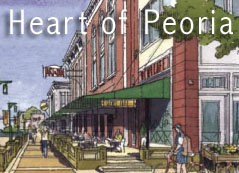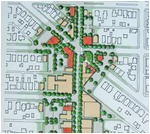 I thought you might be interested to know what’s going on with the Heart of Peoria Commission these days. Here’s a quick look:
I thought you might be interested to know what’s going on with the Heart of Peoria Commission these days. Here’s a quick look:
The Executive Summary
One of the top things on the Heart of Peoria Commission’s work plan this year is to develop an executive summary of the Heart of Peoria Plan. The Plan as it exists now is a large-format (11×17), 78-page color document that is expensive to reproduce (~$150). Even as a commissioner, when I asked for a copy of the document, I was presented with a stapled, single-sided, photocopied, black and white version.
Well, that doesn’t exactly invite people to read the document and catch the vision. So the idea is to create a smaller, shorter, easier-to-reproduce, but still color version of the plan that would give the basic ideas in summary form. This could then be given to anyone who wants or needs to know about the Plan, from citizens to developers to commissioners/council members.
There were two options for getting this done. We could have a staff member do it (Planning and Growth Director Pat Landes offered one of her staff — Kimberly Smith), or we could see if someone from the original team that put the plan together (e.g., David Brain from New College of Florida) would be able to do it for us for a small fee.
We’ve run into roadblocks with both options. The first option (in-house) is stalled because, with the departure of Ed Boik, the Planning and Growth department is short-staffed, and so our staff liaison got pulled off the project. With the latter option, we run into funding issues. The council didn’t give our commission any funding this year, so we would have to try to convince a City department to spend some of their limited funds on this project. We’re still working on that option.
Sheridan Triangle
The Sheridan/Loucks Triangle project is moving along. After the Heart of Peoria Plan was adopted “in principle” by the Council, the next step the Commission did was get it codified for the Plan area. That’s when Farrell Madden came in and wrote the Land Development Code (LDC). The LDC includes four Form Based Code areas: Warehouse District, West Main (Renaissance Park), Prospect Road Corridor, and the Sheridan/Loucks Triangle. After the coding was finished, the Council passed a facade improvement program for the Sheridan/Loucks area (among others), which gave some incentives for the businesses to spruce up their storefronts.
Now in order for the area to really be revitalized, it takes not just private investment, but also public investment. The City needs to improve the streetscape in order for this area to be successful again. Right now the street is too wide, the sidewalks too narrow, and the traffic too fast. By installing wider sidewalks, pedestrian-scale lighting, street trees, and on-street parking, the City will incentivize redevelopment.
Even though this is obviously the culmination of the Heart of Peoria Plan and the LDC that was spearheaded by HOPC, the Commission has not been included in this latest phase yet. We weren’t invited (by accident, we’ve been assured) to the public kick-off meeting at Columbia Middle School. I heard about it, however, and attended anyway. While there, I talked to Gene Hewitt and Nick Stoffer from the City’s Traffic & Engineering department. They mentioned that they thought a Heart of Peoria commissioner should be on the Citizen Advisory Group (CAG).
I told HOPC chairman Bill Washkuhn that I’d be interested in serving on the CAG, and he forwarded my request to Second District Council Member Barbara Van Auken. She responded:
The representatives who are involved at this point are residential and business neighbors. At a later stage, we will seek input from others, including HOPC and Traffic Commissioners. I’ll notify C.J. when we are at a point where his contribution is appropriate.
After a recent Council meeting, I ran into Ms. Van Auken and asked her at what point in the process she would be bringing in the commissions, and she said once the engineers have some feasible options. Evidently she doesn’t want commissioners making suggestions of things that might not be feasible. So, once the engineers have several options from which to choose, she said the HOP and Traffic commissions will be invited to start participating.
Next Meeting
The next Heart of Peoria Commission meeting is scheduled for Friday, April 25, 8:00-10:30 a.m., City Hall, room 404.

 The city’s Planning and Growth Department is spearheading an effort to review the portion of the Land Development Code (LDC) that deals with form-based code districts “to determine if all the regulations are performing as anticipated and to ensure compatible development which meets the purpose statements of the code.” Toward that end, they have done two things:
The city’s Planning and Growth Department is spearheading an effort to review the portion of the Land Development Code (LDC) that deals with form-based code districts “to determine if all the regulations are performing as anticipated and to ensure compatible development which meets the purpose statements of the code.” Toward that end, they have done two things: A public meeting was held Wednesday night at Columbia Middle School to talk about streetscape and intersection improvements in the Sheridan-Loucks Triangle form-based code area. It’s a small stretch of Sheridan road, bounded by the south side of Hanssler on the north, and the north side of McClure on the south.
A public meeting was held Wednesday night at Columbia Middle School to talk about streetscape and intersection improvements in the Sheridan-Loucks Triangle form-based code area. It’s a small stretch of Sheridan road, bounded by the south side of Hanssler on the north, and the north side of McClure on the south.